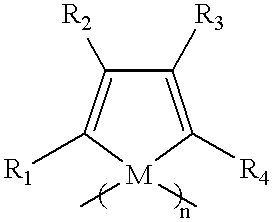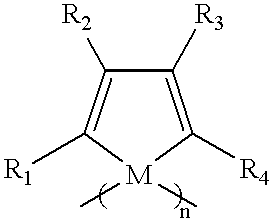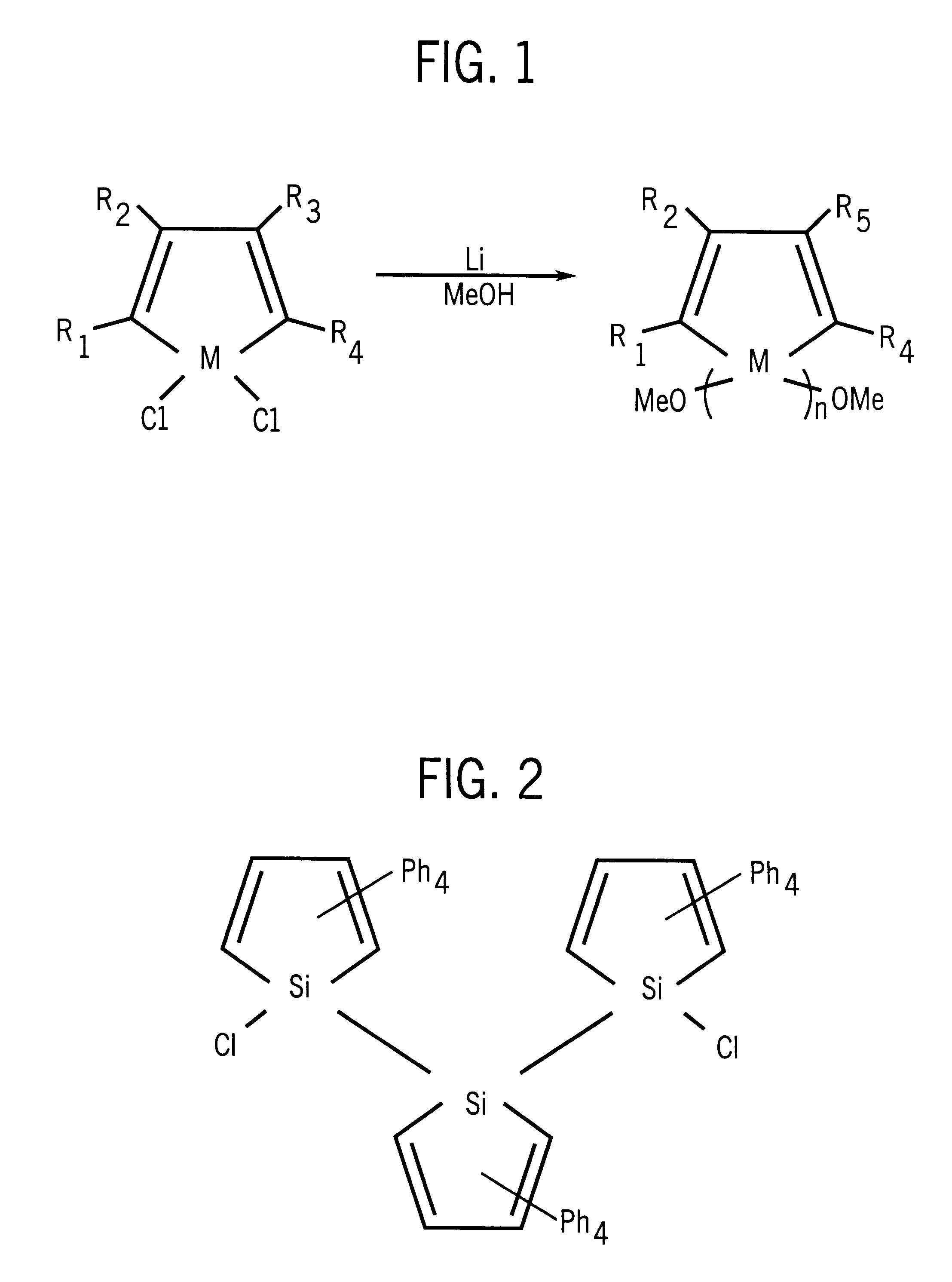Polysiloles and polygermoles
a polygermole and polysilole technology, applied in the field of polygermoles and polygermole copolymers, can solve the problems of limiting the utility of the oligomer, not having desirable film forming properties, and certain desired electrical properties
- Summary
- Abstract
- Description
- Claims
- Application Information
AI Technical Summary
Problems solved by technology
Method used
Image
Examples
example 2
Preparation of poly(2,3,4,5-tetraphenylgermole) polymer by reaction of 2,3,4,5-tetraphenylgermole dianion with 1,1-dichloro-2,3,4,5-tetraphenylgermole in solid phase. A 250 mL schlenk flask with a magnetic stirrer was flame-dried under vacuum and connected to an argon inlet. 1,1-dichloro-2,3,4,5-tetraphenylgermole (see generally West et al., 36 Angewandte Chemie Int. Ed. Engl. 1002-1004 (1996)) (1.50 g, 3.00 mmol), Li metal (94.5 mg, 13.5 mmol) and THF (40 mL) were introduced and stirred at room temperature for 12 hours.
The mixture turned to dark purple and the germole dianion was formed. Another 250 mL schlenk flask with a magnetic stirrer was flame-dried under vacuum and connected to an argon inlet. (1.50 g, 3.00 mmol) of the dichloro compound and THF (50 mL) was introduced and stirred about 15 min. The second flask was cooled to -78.degree. C., then the germole dianion solution in the first flask was introduced by cannulation. THF was removed by evaporating under vacuum at 0.degr...
example 3
Preparation of poly(2,3,4,5-tetraphenylgermole-2,3,4,5-tetraphenylsilole) alternating copolymer by reaction of 2,3,4,5-tetraphenylgermole dianion with 1,1-dichloro-2,3,4,5-tetraphenylsilole in solid phase. A 250 mL schlenk flask with a magnetic stirrer was flame-dried under vacuum and connected to an argon inlet. 1,1-dichloro-2,3,4,5-tetraphenylgermole (1.00 g, 200 mmol), Li metal (62.5 mg, 9.0 mmol) and THF (50 mL) were introduced and stirred at room temperature for 36 hours.
The mixture turned to dark purple and the germole dianion was formed. Another 250 mL schlenk flask with a magnetic stirrer was flame-dried under vacuum and connected to an argon inlet. 1,1-dichloro-2,3,4,5-tetraphenylsilole (0.91 g, 2.00 mmol) and THF (50 mL) was introduced and stirred about 15 min. The second flask was cooled to -78.degree. C., then the germole dianion solution in the first flask was introduced by cannulation. THF was removed by evaporating under vacuum at 0.degree. C. and the resulting dark s...
example 4
Preparation of poly(2,3,4,5-tetraphenylsilole) polymer from 1,1-dichloro-2,3,4,5-tetraphenylsilole using reduction coupling. A 250 mL 3-neck flask was equipped with a condenser connected to an argon inlet, a mechanic stirrer and a 100 mL pressure-equalized dropping funnel. 1,1-dichloro-2,3,4,5-tetraphenylsilole (2.33 g, 5.11 mmol), Na metal (0.29 g, 12.6 mmol) and toluene (40 mL) were mixed and refluxed at 110.degree. C. for 4 hours. The mixture turned red from green during the reaction. Me.sub.2 PhSiCl (1.86 g. 10.1 mmol) was then added from the dropping funnel in less than a minute. The reaction continued for 3 hours under toluene reflux.
The mixture was then cooled to room temperature and quenched with 10 mL of methanol. Toluene (100 mL) was added to dilute the solution, and the mixture was washed with distilled water to remove salts, then filtered to remove a small amount of insoluble residue. The toluene solution was concentrated to 30 mL by evaporating some solvent. The polymer...
PUM
| Property | Measurement | Unit |
|---|---|---|
| temperature | aaaaa | aaaaa |
| PDI | aaaaa | aaaaa |
| PDI | aaaaa | aaaaa |
Abstract
Description
Claims
Application Information
 Login to View More
Login to View More - R&D
- Intellectual Property
- Life Sciences
- Materials
- Tech Scout
- Unparalleled Data Quality
- Higher Quality Content
- 60% Fewer Hallucinations
Browse by: Latest US Patents, China's latest patents, Technical Efficacy Thesaurus, Application Domain, Technology Topic, Popular Technical Reports.
© 2025 PatSnap. All rights reserved.Legal|Privacy policy|Modern Slavery Act Transparency Statement|Sitemap|About US| Contact US: help@patsnap.com



